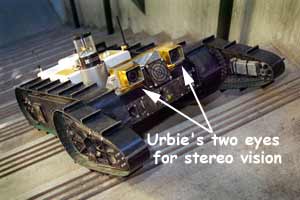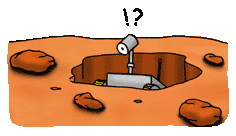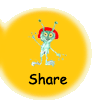
|
Be glad you're not a cyclops!
|
|
Robots that explore other planets must be able to see where they are going. Just like people, robots make good use of two eyes. Why are two eyes so much better than one? |
|
|
Try an experiment. Cover or shut one eye and try to thread a needle. Even a BIG needle. Now try it with both eyes open. Isn't it a lot easier with both eyes? |
|
Or, using only one eye, try pouring water from one container into another--especially into one with a narrow opening. Better have a mop ready! Now try it with both eyes. |
|
|
Shut one eye and the world looks flat--2-dimensional. Keep both eyes open, and the world takes on a whole new dimension! 3-D, or stereo, vision helps us tell how far away things are. Human stereo vision is a good thing for engineers to try to copy in making robots that can get around on their own. Because your eyes are separated by a few centimeters (a couple of inches), each eye sees a slightly different image. Your brain, however, combines the two images into one, using the extra information to tell you how close or far away things are. Roving robots, too, must be able to tell how far away things are. Otherwise the robot will bump into things and have a hard time reaching its target. |
|
|
|
"Urbie" is a Tactical Mobile Robot. Urbie is being designed to navigate city terrain. It will be useful for dangerous military missions, and it will also be useful to police and emergency rescue workers. |
|
Urbie can see and navigate by itself, with no help from humans. Urbie would also make an ideal space explorer.
|
|
|
|
|||||




 For a
robot, exploring an asteroid, comet, or another planet will
be a lonely job. It takes minutes or hours for a message
(such as an image) from a robot on a distant planet to reach
a human on Earth and for a message to be sent back to the
robot. By that time, the little "one-eyed" robot could have
fallen into a hole or gotten stuck somewhere. Like Urbie,
space exploring robots have got to be clever enough to take
care of themselves.
For a
robot, exploring an asteroid, comet, or another planet will
be a lonely job. It takes minutes or hours for a message
(such as an image) from a robot on a distant planet to reach
a human on Earth and for a message to be sent back to the
robot. By that time, the little "one-eyed" robot could have
fallen into a hole or gotten stuck somewhere. Like Urbie,
space exploring robots have got to be clever enough to take
care of themselves.




